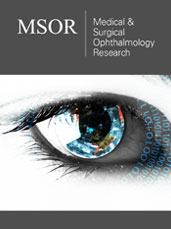- Submissions

Full Text
Medical & Surgical Ophthalmology Research
Color Blindness (Color Vision Deficiency– Daltonism)
Ana Cristina Selvi Daniel*
Ophthalmologist, São Paulo, Brazil
*Corresponding author: Ana Cristina Selvi Daniel, Ophthalmologist, São Paulo, Brazil
Submission: October 23, 2020;Published: November 06, 2020

ISSN 2578-0360 Volume3 Issue1
Opinion
Color Blindness is the decreased ability to see colors or differences in color and may make some educational activities more difficult. However, problems are generally minor, and most color-blind people adapt. People with total color blindness (Achromatopsia) may also be uncomfortable in bright environments and have decreased visual acuity. Color Blindness is typically an inherited genetic disorder most commonly X-linked recessive inheritance. This means that a woman who cares this gene has 50% possibility to transmit to his son and, if she has the illness, 100% possibility to transmit. In almost all cases people retain blueyellow discrimination, and most color-blind individuals are anomalous trichromats rather than complete dichromats (they often confuse red and green items).
Classification
Monochromacy as known as “total color blindness” (Rod or Cone Monochromacy).
Dichromacy- Protanopia (absence of red retinal photoreceptors) difficulties distinguishing
between blue and green colors and red and green colors. 1% of males are affected.
Deuteranopia-affects hue discrimination in similar way to protanopia. 1% of males are
affected. Tritanopia-only red and green pigments are present with a total absence of blue
retinal receptors, rare situation. Anomalous trichromacy is a common type of inherited color
vision deficiency. Protanomaly-mild color vision defect with altered spectral sensitivity of red
retinal receptors. Hereditary sex-linked (1% of males). Deuteranomaly-altered green retinal
receptors: Most common type affecting red-green hue discrimination in 5% European males.
Hereditary sex-linked.
Tritanomaly-affects blue-green and yellow-red/pink hue discrimination. Some of the
inherited diseases known to cause blindness are
a. Cone dystrophy
b. Cone-rod dystrophy
c. Achromatopsia
d. Blue cone monochromatism
e. Leber’s congenital amaurosis
f. Retinitis pigmentosa
Diagnosis
Sometimes is difficult to diagnose specially when we have a mild color blindness. In serious type swe can find visual chromatic tests as Ishihara and Farnsworth 100 Hue. These tests can be done in pre-school students but is easier to evaluate in students with 10 years old and more. Most clinical tests are designed to be fast, simple, and effective at identifying broad categories of color blindness. Electroretinography-Evaluate the retinal function by capturing the electrical activity on light stimulation. There is no cure for color deficiencies. But they can use lenses increasing the contrast between colors enhancing the chromatic discrimination. Many mobile and computer apps have been developed to help color blind individual to view better. Color blindness may make it difficult or impossible for a person to engage in certain occupations. A Brazilian court ruled that people with color blindness are protected by Inter-American Convention on the Elimination of all Forms of Discrimination against Person with Disabilities.
Conclusion
Conclusion It is important to monitoring the child and observe her behavior when the same cannot answer correctly about colors. Also, important to do an ophthalmological control since pre-school ages. By age 5 children with normal color vision can identify all of groups of colors in a couple of seconds.
© 2020 Ana Cristina Selvi Daniel. This is an open access article distributed under the terms of the Creative Commons Attribution License , which permits unrestricted use, distribution, and build upon your work non-commercially.
 a Creative Commons Attribution 4.0 International License. Based on a work at www.crimsonpublishers.com.
Best viewed in
a Creative Commons Attribution 4.0 International License. Based on a work at www.crimsonpublishers.com.
Best viewed in 







.jpg)






























 Editorial Board Registrations
Editorial Board Registrations Submit your Article
Submit your Article Refer a Friend
Refer a Friend Advertise With Us
Advertise With Us
.jpg)






.jpg)














.bmp)
.jpg)
.png)
.jpg)










.jpg)






.png)

.png)



.png)






